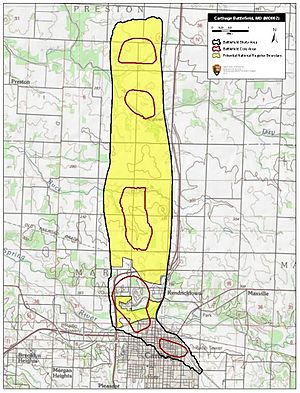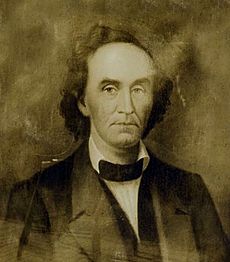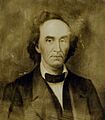Battle of Carthage, Missouri facts for kids
Quick facts for kids Battle of Carthage |
|||||||
|---|---|---|---|---|---|---|---|
| Part of the Trans-Mississippi Theater of the American Civil War |
|||||||
 Carthage Battlefield |
|||||||
|
|||||||
| Belligerents | |||||||
| Commanders and leaders | |||||||
| Units involved | |||||||
| Missouri State Guard | 2d Brigade, Missouri Volunteers | ||||||
| Strength | |||||||
| 4,000 armed 2,000 unarmed |
1,100 | ||||||
| Casualties and losses | |||||||
| 200 | 44 | ||||||
The Battle of Carthage was an important fight at the start of the American Civil War. It happened on July 5, 1861, near Carthage, Missouri. This battle showed how divided the state of Missouri was.
Colonel Franz Sigel led about 1,100 soldiers who wanted Missouri to stay with the Union. On the other side, Governor Claiborne Fox Jackson of Missouri led the Missouri State Guard. His force had over 4,000 armed soldiers, plus 2,000 who were not armed. These soldiers were led by Sterling Price, a hero from the Mexican–American War.
Contents
Why Did the Battle of Carthage Happen?
Missouri's Divided Loyalties
Before the Civil War, people in Missouri had very different ideas. Many in St. Louis and nearby areas supported the Northern states. Their economy was linked to the North. Also, this area had few enslaved people and many German immigrants who were against slavery.
However, Missouri's Governor, Claiborne Fox Jackson, supported the Southern states. The rest of Missouri was deeply split. Governor Jackson publicly tried to stay neutral. But Union supporters thought he was secretly getting the state militia ready. They feared he wanted to take over the Federal Arsenal in St. Louis.
President Lincoln's Call for Troops
In April 1861, after the attack on Fort Sumter, President Abraham Lincoln asked all states for soldiers. He wanted to stop the Confederacy. Missouri was asked to send four groups of soldiers.
Governor Jackson refused this request. Instead, he called up the Missouri Volunteer Militia. Union leaders worried he might use them to capture the St. Louis Arsenal. But Captain Nathaniel Lyon, the new commander of the arsenal, stopped this plan.
Captain Lyon's Actions in St. Louis
Captain Lyon had strong feelings against slavery. He quickly joined with "Unconditional Unionists" in St. Louis. These Unionists were worried that Governor Jackson would use local groups to seize the Arsenal.
So, on April 22, 1861, Lyon gathered four groups of Federal Missouri Volunteers. He gave them weapons from the Arsenal. President Lincoln then ordered most of the remaining weapons to be moved to Illinois. This was done secretly on the night of April 24–25, 1861.
The situation got worse when Confederate weapons arrived at a state militia camp called Camp Jackson. Lyon marched his soldiers to the camp to arrest the militia. He forced them to surrender and marched the prisoners through St. Louis. This event, known as the Camp Jackson affair, led to protests and even a riot.
Despite the protests, many Unionists supported Lyon. They included Congressman Francis Preston Blair Jr.. Lyon was promoted to brigadier general.
How the Battle Started: The Road to Carthage
Failed Peace Talks
On June 10, 1861, General Lyon met with Governor Jackson and General Sterling Price. They met at a hotel in St. Louis to try and find a peaceful solution. But the meeting failed. Both sides made demands the other could not accept.
After four hours, Lyon ended the meeting. Jackson and Price went back to Jefferson City. They ordered railroad bridges to be burned behind them to slow down Union forces.
Union and State Guard Movements
Lyon moved his soldiers up the Missouri River to capture Jefferson City. Meanwhile, Colonel Franz Sigel led another group of Union troops. They moved from St. Louis into southwest Missouri. Sigel hoped to block any Missouri State Guard forces trying to retreat south.
On June 12, Sigel began moving his soldiers toward Springfield. The Missouri State Guard in Jefferson City retreated to Boonville. Lyon quickly took Boonville and chased the State Guard south.
Another group of State Guardsmen also moved south from Lexington. Sigel's troops reached Springfield and took control. They then prepared to march to Carthage. They hoped to catch the retreating State Guardsmen there.
Gathering Forces Near Carthage
Jackson's and Price's units met in Lamar on July 3. Jackson's army grew to 6,000 men. Many joined as they marched south. However, most of these new soldiers had only hunting rifles, shotguns, or no weapons at all.
On July 4, Sigel arrived at Carthage with his 1,100 men. He knew the Missouri State Guard was camped near Lamar, about 18 miles north of Carthage. That night, small groups of State Guard soldiers clashed with Sigel's guards outside Carthage. Both sides now knew where the other was.
The Battle of Carthage: A Clash of Armies

When Governor Jackson learned Sigel was in Carthage, he decided to attack. He planned to strike the smaller, but better-armed, Union force. On the morning of July 5, Jackson marched his new soldiers south.
The two armies met about 10 miles north of Carthage. The State Guard put up two Confederate flags on either side of their line. Their line stretched for over half a mile. Sigel's men formed a battle line and moved close to the State Guard.
Fighting Begins
Sigel started the battle with his artillery (cannons). He then moved closer to attack. Jackson fired back with his own cannons. Jackson and the State Guard then chased Sigel's soldiers.
They fought as they pushed the Union troops 10 miles south. The fighting continued until both forces reached the edge of Carthage. Jackson had his men try to surround Sigel's force.
Retreat and Pursuit
The battle continued steadily through the day. Both sides then had some smaller fights in the Carthage town square. At this point, Sigel saw a large group of State Guardsmen moving into the woods. He didn't know they were mostly unarmed recruits.
Fearing they would attack his side, Sigel ordered a retreat. The State Guard chased them. But Sigel managed a good fighting retreat, protecting his soldiers. By evening, Sigel was back in Carthage. Under the cover of darkness, he retreated further to Sarcoxie.
What Happened After the Battle?

The Battle of Carthage was a win for the Missouri State Guard. This was partly due to new fighting methods used by Captain Joseph O. Shelby and his "partisan rangers." These were independent fighters who helped the State Guard.
Carthage played a role in how Missouri acted during the war. It helped encourage many people to join the Southern armies. Robert Wells Crawford, a lawyer who fought in the battle, later became a recruiter for the Confederate States Army in Missouri.
Why Was This Battle Important?
The Battle of Carthage was the first major battle after President Lincoln began using his "war power" on July 4, 1861. It is also the only time a sitting U.S. State governor led troops in battle against the Union.
Captain Jo Shelby's rangers were at the front of Governor Jackson's army. They helped turn the tide of the battle. Their actions helped the pro-Confederate side in Missouri celebrate their first victory.
The fighting throughout the war caused many people to leave Jasper County. The town of Carthage was also destroyed. This made way for new settlements later on.
Protecting the Battlefield
The American Battlefield Trust and its partners work to save historic battlefields. They have helped protect about 180 acres of the Carthage battlefield.
Images for kids




